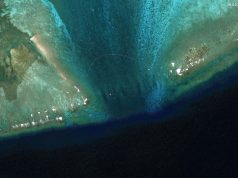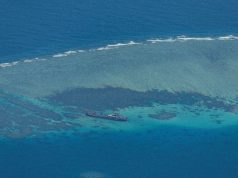
SOUTH CHINA SEA — Japan’s largest warship steamed into the South China Sea this week in defiance of Chinese assertiveness, with Asian military guests on board to witness helicopters looping over the tropical waters and gunners blasting target buoys.
China claims most of the energy-rich sea through which about $5 trillion in ship-borne trade passes every year, much of it to and from Japanese ports. Neighbors Brunei, Malaysia, the Philippines, Taiwan and Vietnam also have claims.
Japan worries that China is cementing its control in the South China Sea with manmade island bases, arms sales and development aid.
“We are not just here to show our presence, but from the outside that is what it looks like,” Rear Admiral Yoshihiro Goga, the commander of the mission, said aboard the Izumo-class helicopter carrier.
Military officers from the ten-member Association of Southeast Asian Nations boarded the 248-meter carrier in Singapore on Monday. It returned on Friday after demonstrating naval skills and kit Tokyo hopes will help it bolster alliances in the region.
The Izumo turned back to Singapore before crossing a boundary known as the nine-dash-line into what China claims are its waters.
The high-profile cruise was part of a hitherto unseen coordinated push by Japan’s Self Defense Forces and defense bureaucrats to bolster ties with countries ringing the contested waters. It also marked a concerted push into military diplomacy by hawkish Japanese Prime Minister Shinzo Abe.
Japan last week held a military technology seminar near Tokyo for representatives from Thailand, Vietnam, the Philippines, Indonesia and Singapore and this week invited ASEAN officers to a disaster relief drill in Tokyo.
Abe’s government believes Japan may be better placed to steer Southeast Asian nations away from Chinese influence than its U.S. allies with a gentler approach that emphasizes a common Asian heritage, two sources with knowledge of the diplomatic strategy told Reuters earlier.
While the U.S. has confronted China directly by sending warships close to China’s island bases in the South China Sea, Japan so far has shied away from similar provocations.
As the Izumo neared the nine-dash line, the crew were on lookout for Chinese aircraft or ships sent to shadow the flag ship. Apart from brief radar contact with an unidentified aircraft announced by the ship’s public address system the carrier, however, sailed on unmolested.










